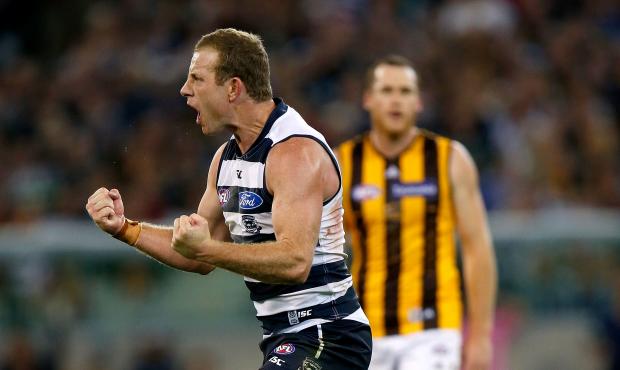Much in the game has changed in the 2033 days that have passed since that upset.
It's a sign of the times that 14 fewer free kicks were paid on Monday than were awarded in the 2008 Grand Final.
Click here to read more of the Numbers Game
That was despite 15 more tackles, 52 more contested possessions and 14 more contested marks being recorded in the 2014 game.
There were also six more ball-ups around the ground (36-30) and two more boundary throw-ins (25-23) on Monday than in 2008.
Yet somehow the Cats and the Hawks still rule the roost (and the Cats still manage to win free kicks for high contact!).
As Hawthorn coach Alastair Clarkson's sagely noted post-game, it's the Cats' strong system that underpins their success.
The same could be said for the Hawks.
The two clubs share five of the past seven premierships.
How those systems have stood up as the game has changed is intriguing.
Geelong is more direct and more considered in its ball use than it was in 2008.
Hawthorn's kicking efficiency has been lauded but in both games their efficiency has hovered around 75 per cent.
Geelong had nine more kicks on Monday, but 49 fewer disposals than it did in the 2008 decider. It's not as handball happy as it once was.
Geelong still shares the ball around much more inside 50 than the Hawks (60-38 forward 50 disposals in 2008, 75 to 38 in 2014) and less in defensive 50 (53 to 92 in 2008, 62 to 92 in 2014).
Cats star Stevie Johnson celebrates a goal on Easter Monday at the MCG. Picture: AFL Media

However, the Cats use the ball much more efficiently through the midfield now than they did in 2008 (265 midfield disposals in 2008 to 192 on Monday).
It went long and direct to Hawkins and it reaped the rewards with 20 marks inside 50, seven more than it managed in 2008 when Cameron Mooney and Tom Lonergan were the tall targets inside 50.
The most significant change to come through the numbers is that Geelong no longer plays on after a mark as a matter of course.
In the 2008 Grand Final it played on after a mark 58.8 per cent of the time in the defensive and midfield parts of the ground but on Monday it did so just 37.3 per cent of the time.
That is similar to Hawthorn's approach in both games.
The Cats won the elevated contested ball count on both occasions (52.6 percent in 2008 and 51.7 percent in 2014) but they dramatically reduced the Hawks' uncontested mark number on Monday (from 127 in 2008 to just 66 in 2014).
This was an important feature of the win, with the disciplined approach a feature of Geelong since its undisciplined approach in 2008.
It still tackles inside 50 more than the Hawks (16 to 7 in 2008, 19 to 5 in 2014) and importantly the addition of Jared Rivers seems to have lifted the number of intercept marks it takes (17 in 2014 and 11 in 2008 (although exceptional intercept marker Tom Harley was concussed in 2008).
In its 13 games against Hawthorn since the 2008 Grand Final, both Geelong and Hawthorn have averaged 27 scoring shots a game.
In the two games six years apart however, Geelong exceeded 30 scoring shots on both occasions (34-25 in 2008 and 31-27 on Monday) but famously won just one game.
Geelong's rushed behind count in 2008 was 11, high enough to see the rules relating to rushed behinds changed. On Monday it was five.
Poor goal kicking is often blamed for Geelong's 2008 loss but it kicked 8.6 from set shots on that day and managed a similar 9.6 on Monday.
Set-shot conversion is one aspect of the game unlikely to change.
Allowance must be made for the fact that Geelong did not play the way it wanted to back in 2008, but it has not made that same mistake twice.
It has continued to be harder for longer in 12 of the past 13 games against Hawthorn.
One element both clubs have had is a strong core of talented players on its list throughout.
It might surprise some to note that Geelong still had 10 players from its 2008 team play on Monday, compared to Hawthorn's six.
However the Hawks have added quality through smart acquisitions while Geelong's development program has been superb.
Geelong's team on Monday had 10 games more experience on average than in 2008 (113 to 103) while the Hawks had 18 games more experience (105 to 87).
For its players to keep turning up ready to win for the 120-plus games it has played in the past five seasons is a feat all other clubs respect.
And long may it continue, so that the epic battle for supremacy in the expansion era can continue unabated.
Evolving champion
Geelong midfielder Steve Johnson had the same number of disposals on Monday as he did in the 2008 Grand Final but his impact on the game was much different two days ago.
The 30-year-old's three goals, 11 contested possessions and 65 percent of his disposals in the midfield, compared favourably to one goal, seven contested possessions and 74 percent of his possessions in the midfield as a 25-year-old.
Best on ground on Monday, his effort in 2008 was rated as ineffective.
Stats supplied by Champion Data


